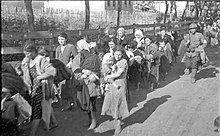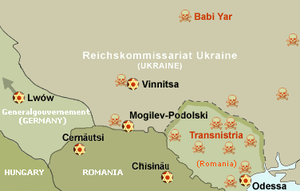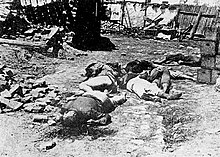
1941 Odessa massacre

| 1941 Odessa massacre | |
|---|---|
| Part of the Holocaust | |
 Column of Jewish civilians deported to Transnistria escorted by Romanian soldiers | |
| Location | Odessa |
| Date | 22–24 October 1941 |
Attack type | Mass murder, genocide, ethnic cleansing |
| Deaths | 34,000–100,000 |
| Injured | Unknown |
| Victims | Mainly Jews, also Romani people |
| Perpetrators | Support: |

The Odessa massacre was the mass murder of the Jewish population of Odessa and surrounding towns in the Transnistria Governorate during the autumn of 1941 and the winter of 1942 while it was under Romanian control. It was one of the worst massacres in Ukrainian territory.[1]

Depending on the accepted terms of reference and scope, the Odessa massacre refers either to the events of October 22–24, 1941 in which some 25,000 to 34,000 Jews were shot or burned, or to the murder of well over 100,000 Jews in the town and the areas between the Dniester and Bug rivers, during the Romanian and German occupation which took place following the massacre. As of 2018, it was estimated that up to 30,000 people, mostly Ukrainian Jews, were murdered in the actual massacre, which occurred October 22–23, 1941.[2] The primary perpetrators were Romanian soldiers, Einsatzgruppe SS and local ethnic Germans.[3][4]

Background
Before the war, Odessa had a large Jewish population of approximately 200,000, or 30% of the city's total population. By the time the Romanians had taken the city, between 80,000 and 90,000 Jews remained, the rest having fled or been evacuated by the Soviets. As the massacres occurred, Jews from surrounding villages were interned in Odessa and Romanian concentration camps set up in the surrounding areas.

On October 16, following a two-month siege of Odessa, the Germans and Romanians captured the city.

Mass killings of hostages and Jews on October 22–24

Destruction of the Romanian commandant's office
On October 22, 1941, in the building of the NKVD on the Marazlievskaya street where the Romanian military commander's office and the headquarters of the Romanian 10th Infantry Division had settled to occupy the city, a radio-controlled mine exploded. The mine had been planted there by the sappers of the Red Army before the surrender of the city by Soviet troops. The building collapsed, and under its rubble, 67 people were killed, including 16 officers, among whom was the military commander of the city, Romanian General Ioan Glogojeanu. Responsibility for the explosion was placed on the Jews and Communists.

The execution of hostages
In response to the explosion at the commandant's office, General Nicolae Tătăranu received a direct order from Marshal Ion Antonescu, ordering "immediate reprisals" be carried out on the Jewish population.[5] The Romanian troops and the German "Einsatzgruppe" arrived in Odessa on October 23 to kill from 5,000 to 10,000[6]: 151 hostages, many of whom were Jews.[7]

Across the Marazlievskaya street, occupiers broke into the apartments of Odessa citizens and shot or hanged all residents found, without exception. They raided the streets and markets of the city and suburbs, and people who knew nothing of the bombing were shot on sight against fences or the walls of houses. Nearly 100 men were seized and shot at the Big Fountain, about two hundred people were executed in the Slobodka neighborhood near the market, 251 residents were shot in Moldavanka, Near and Far Windmills and in Aleksandrovsky Prospekt about 400 townspeople were executed. The columns of the captured hostages were driven to the area of artillery warehouses on Lustdorf Road, where they were shot or burned alive.[6]: 145

After the war, more than 22,000 corpses were found in mass graves.[8]

The beginning of the Holocaust
On October 23, an order was issued threatening all Jews with death on the spot and ordering them to report to the village of Dalnyk on October 24. In the afternoon of October 24, about 5,000 Jews were gathered near the outpost of Dalnyk. The first 50 people were brought to the anti-tank ditch and shot by the commander of the 10th machine-gun battalion, Lieutenant-Colonel Nicolae Deleanu.[9]

Military Command of the mountains. Odessa brings to the attention of the population of Odessa and its surroundings that after the terrorist act committed against the Military Command on October 22, on the day of October 23, 1941, were shot: for every German or Romanian officer and civilian official 200 Bolsheviks, and for every German or Romanian soldier 100 Bolsheviks. All the communists in Odessa will be taken hostage, which, if repeated such acts, will be shot together with their families. [10]
— Commander of troops: Gendarmerie Lieutenant Colonel Mihail Niculescu
To speed up the process of destruction, the Jews were driven into four barracks, in which holes were made for machine guns, and the floor was pre-filled with gasoline. People in two barracks were shot with machine guns on the same day. At 17:00 the barracks were set on fire. The next day, the prisoners were shot, placed in the remaining two barracks, and in one of the barracks grenades were thrown.[11]

Meanwhile, the Jews who were not selected for the first group, and who had already arrived in Dalnyk, were told that they were "forgiven". They were sent to various military headquarters and Gendarmerie stations for "registration", where they were detained for different lengths of time. When they were released, they discovered that their houses had been occupied and their property plundered.

During the first week of Romanian occupation of Odessa, the city lost about 10% of its inhabitants.[6][12]

Subsequent events

The registration carried out by the Romanian administration in late 1941 counted about 60,000 Jews in Odesa. This number included persons having only one Jewish ancestor. Jews were required to wear a special distinctive badge, a yellow hexagram (Magen David, the Star of David, a symbol of Judaism) on a black background.[13]

On November 7, 1941, an order was issued, making it mandatory for all male Jews from 18 to 50 years old to report to the city prison.

I order:
Art. 1 All men of Jewish origin, aged 18 to 50 years, are obliged within 48 hours from the date of publication of this order to report to the city prison (Bolshefontanskaya road), having with them the essentials for existence. Their families are obliged to deliver food to them in prison. Those who did not obey this order and found after the expiration of the indicated 48-hour period will be shot on the spot.

Art. 2 All residents of the city of Odessa and its suburbs are required to notify the relevant police units of every Jew of the above category who has not complied with this order. Coverers, as well as persons who know about this and do not report, are punishable by death.
— Head of the Military Police: Hor. Odessa Lieutenant Colonel M. Niculescu
From that day on, the entire Jewish population of the city was sent to concentration camps, organized by Romanians in the countryside, primarily to the village of Bogdanovka (now in the Mykolaiv Oblast). Later, a ghetto was arranged in Odessa itself.[6]: 172

The Romanian administration took measures to seize the property of future victims. In mid-November, a new order was issued clarifying the authorities' demands for Jews. It said:[6]: 171

... All persons of Jewish origin are obliged at the registration to the Military Command or police officials to voluntarily declare all their precious objects, stones and metals. Those guilty of violating this order will be punished with the death penalty
By the middle of December, about 55,000 Jews were gathered in Bogdanovka, though some of them were not from Odessa. From December 20, 1941, until January 15, 1942, each of them was shot by a team of the Einsatzgruppe SS, Romanian soldiers, Ukrainian police and local German colonists.[3][4]

A month later, a death march of 10,000 Jews was organized in three concentration camps in Golta.

In January 1942, about 35,000-40,000 of the Jews left in Odessa were evicted and sent to the ghetto that had been created on January 10, 1942, in the poor area of Slobodka. The evicted endured terrible conditions; with inadequate housing for all and severe crowding, many were forced out into the open winter air, which led to mass mortality from hypothermia.[14][15][16]

From January 12 to February 20, 1942, the remaining 19,582 Jews were deported to Berezivka Raion of Odessa Oblast. They were transported in unheated echelons, and many died on the road. In Berezivka, groups were forced to walk to Domanevka, Bogdanovka, Golta and other concentration camps. Many died of hunger and cold along the way. The guards, consisting of Romanian and German soldiers, organized mass executions of Jews during the journeys. In 18 months, almost all the prisoners of Golta died.[14]

The survivors of the Holocaust
Some Jews were sent to work in the villages, and about half of them survived the occupation. The situation in the ghetto of Domanevka and other ghettos in Transnistria improved in 1943 after the Jews began to receive assistance from Jewish organizations in Romania.[17] About 600 Odessa residents in these ghettos lived to be released. Several hundred Jews who were hiding in Odessa itself also survived. Jews participated in the struggle of the Odessa underground and constituted a significant part of the guerrilla units, based in the Odesa catacombs.[3]

Trials and punishment of the main perpetrators
At the Bucharest People's Tribunal, set up in 1946 by the new Romanian government in conjunction with the Allied Control Council, one of the charges brought against Marshal Ion Antonescu, the Governor of Transnistria, Gheorghe Alexianu, and the commander of the Odessa garrison, General Nicolae Macici, was "the organization of repressions against the civilian population of Odessa autumn of 1941". For these crimes, they were sentenced to death. The first two were shot on July 1, 1946. Later, King Michael commuted Macici's death sentence to life imprisonment. Macici died in prison in 1950.

In response to the appeal of the verdict filed by the son of Alexianu, on November 5, 2006, Bucharest Court of Appeal confirmed the verdict of war criminals to death, dated May 17, 1946. In response to the appeal filed by the Prosecutor General, on May 6, 2008, the case was re-examined and the judges of the High Court of Cassation and Justice finally rejected the application for revision of the 1946 sentence.[18]

Commemoration
Memorial in Prokhorovsky Square
In the early 1990s in Odessa's Prokhorovsky Square, where the "road of death" to the extermination camps for Odessa's Jews and Gypsies had begun on the outskirts of the city in 1941, a memorial commemorating the victims of the Holocaust was created. A memorial sign was installed, along with the "Alley of the Righteous Among the World", featuring trees planted in honor of each Odessa citizen who had harbored and saved the Jews. The complex was completed in 2004 with the erection of a monument to the victims of the Holocaust in Odessa by sculptor Zurab Tsereteli.[19][20]

-
Memorial to the victims of the Holocaust
-
Monument by Zurab Tsereteli
-
Alley of the "Righteous Among the World".
-
Memorial sign
-
Memorial sign
The Holocaust Museum in Odessa
The Museum of the Holocaust in Odesa was created in accordance with the decision of the Council of the Odesa Regional Association of Jews, former prisoners of the ghetto and Nazi concentration camps. The chairman of the association is Roman Shvartsman. The opening of the museum took place on June 22, 2009.[21]

Other
In January 2015, the authorities of the Italian town of Ceriano Laghetto, in the province of Monza-e-Brianza in the Lombardy region, named a city square "Martyrs Square of Odesa" in memory of the victims of the occupation regimes in Odesa: Jews killed October 22–24, 1941, as well as anti-Maidan activists, rescuers and accidental victims who died on May 2, 2014, in the Odesa Trade Union House.[22][23]

On May 2, 2015, the first anniversary of the events in the House of Trade Unions, a commemorative monument dedicated to the "Martyrs of Odesa" was opened at this square. The monument is a tongue of flame with a silhouette of a dove, a symbol of the world, inside.[24]

The 2018 tragicomic Romanian film I Do Not Care If We Go Down in History as Barbarians deals with the massacre and historical memory among modern Romanians.

See also
- List of massacres in the Soviet Union
- List of massacres in Ukraine
- History of the Jews in Odesa
- Hostages Trial
- Romania in World War II
- The Holocaust in Romania
- Bibliography of the Soviet Union during World War II
- Bibliography of Ukrainian history § Holocaust
References
- ^ Ugo Poletti. The Forgotten Holocaust: The Massacre of Odesa’s Jews Kyiv Post. Retrieved 18 December 2022
- ^ "The Odessa massacre: Remembering the 'Holocaust by bullets'". Deutsche Welle. 22 October 2018. Retrieved 1 March 2022.
- ^ a b c Kotlyar, Yuri. "Bogdanov tragedy - Holocaust against the Jewish population" (PDF). KBY Kiev. Retrieved 14 May 2018.
- ^ a b "Association of Jewish Organizations and Communities of Ukraine (Vaad of Ukraine)". Association of Jewish Organizations and Communities of Ukraine. Archived from the original on 27 May 2009. Retrieved 14 May 2018.
- ^ Simion, Adrian (2014). "Terra Sebus. Acta Musei Sabesiensis, 6, 2014, p. 529-549. PROBLEMA HOLOCAUSTULUI REFLECTATĂ ÎN PAGINILE REVISTEI ROMÂNIA MARE ÎN PERIOADA ANILOR 1990-2000" (PDF). Journal of the Sabesian Museum. 6: 533. Retrieved 23 July 2022.
- ^ a b c d e Cherkasov, Alexander Anatolievich (2007). Occupation of Odessa. Year 1941. Odessa: Optimum. p. 264. ISBN 978-966-344-144-3. Archived from the original on 26 July 2021. Retrieved 13 May 2018.
- ^ "Shoah in Transnistria: tragedy of Odessa Jewry". Yad Vashem. Holocaust Memorial Complex. Archived from the original on 15 August 2018. Retrieved 13 May 2018.
- ^ Vishnevskaya, Irina. "Memory ... past ... occupation". Odesskiy.com. Retrieved 13 May 2018.
- ^ Umrikhin, Alexander (3 February 2015). "Odessa: unbroken hero city". TV Center. Retrieved 13 May 2018.
- ^ Traşcă, Ottmar. "OCUPAREA ORAŞULUI ODESSA DE CĂTRE ARMATA ROMÂNĂ ŞI MĂSURILE ADOPTATE FAŢĂ DE POPULAŢIA EVREIASCĂ, OCTOMBRIE 1941 – MARTIE 1942" (PDF). Institutul de Istorie. Archived from the original on 13 November 2019. Retrieved 31 December 2024.
{{cite web}}: CS1 maint: bot: original URL status unknown (link) - ^ Cohricht, Felix. "Odessa, October, 1941. Memory…". Odesskiy.com. Retrieved 13 May 2018.
- ^ "The Romanian Jewry: Historical Destiny, Tolerance, Integration, Marginalisation". JSRI. Retrieved 14 May 2018.
- ^ Borovoi, S. Ya.; Volsky, S.A.; Glyadkovskaya, A.I.; Gotlov-Gotlib, A.G.; Dobrolyubsky, K.P.; Sosnovsky, I.A. (2011). Odessa. An outline of the history of the city-hero to the 150th anniversary of the foundation. Essays. Odessa: Optimum. p. 322.
- ^ a b "Chronologie Geschichtein". Geschichteinchronologie. Retrieved 14 May 2018.
- ^ "Memorable dates of Jewish history". Electronic Jewish Encyclopedia. Retrieved 14 May 2018.
- ^ Hasin, Arkady. "January 10, 1942 Odessa, the Slobodka district". Purely Odessa site. Retrieved 14 May 2018.
- ^ Rozen, Marcu. "The General Demographic Balance of the Jewish Population From the Former Greater Romania and Transnistria". Archive Today. Archived from the original on 29 May 2012. Retrieved 14 May 2018.
- ^ "Instanta Suprema a respins reabilitarea maresalului Antonescu". ZIUA. Retrieved 14 May 2018.
- ^ "Holocaust Memorial". Otdyhaem (in Ukrainian). Retrieved 14 May 2018.
- ^ "Zurab Konstantinovich Tsereteli". Russian Academy of Arts (in English). Retrieved 21 February 2022.
- ^ "A museum of the Holocaust was opened in Odessa". Dumskaya. Retrieved 14 May 2018.
- ^ Tumanova, Anna (11 February 2015). Площадь Мучеников Одессы есть и будет: интервью с мэром города Чериано Лагетто [The Martyrs' Square of Odesa is and will be: an interview with the mayor of the city of Ceriano Lagetto]. Regnum. Retrieved 14 May 2018.
- ^ Suchkov, Eugene (19 January 2015). В Италии появилась площадь Мучеников Одессы [In Italy appeared the Martyrs' Square of Odesa]. Komsomolskaya true. Retrieved 14 May 2018.
- ^ "Un monumento ricorda i 'Martiri di Odessa'". Сeriano Laghetto. 9 May 2015. Retrieved 14 May 2018.
Sources
- Dallin A. (1998). Big Book with Many Chapters and Two Co-authors. Romanian Historical Studies. Iasi-Oxford-Portland. p. 296. ISBN 9739839118. Archived from the original on 28 September 2007. Retrieved 14 May 2018.
- Cherkasov A.A. (2006). Defense of Odessa. Pages of truth. Great literary and artistic series "All Odessa" Issue 15. Odessa: Optimum. p. 296. ISBN 966-344-012-0. Archived from the original on 28 September 2007. Retrieved 14 May 2018.
- Cherkasov A.A. (2007). Occupation of Odessa. Year 1941. Essays. Great literary and artistic series "All Odessa" Issue 15, Issue 18. Odessa: Optimum. p. 270. ISBN 978-966-344-144-3.
- Jewish. communities. center "Migdal" (2006). History of the Holocaust in the Odessa region. Collection of articles and documents. Great literary and artistic series "All Odessa" Issue 18. Odessa: Optimum. pp. 372 + [136] with illustrations, 22 tables. ISBN 966-344-144-5.
- Aleksandrovich I.A. (2014). The ways of death. Notes gettovtsa. Odessa: Art-Brand. pp. 240 with illustrations. ISBN 978-5-9901362-2-9.
Further reading
- Weinberg, Robert; John D. Klier; Shlomo Lambroza (1992). "The Pogrom of 1905 in Odessa: A Case Study excerpts". Pogroms: Anti-Jewish Violence in Modern Russian History: 248–89. Archived from the original on 4 April 2016. Retrieved 1 August 2006.
External links
 Media related to The Holocaust in Romania at Wikimedia Commons
Media related to The Holocaust in Romania at Wikimedia Commons- "Report on the role of Romania in the Holocaust" (PDF). www.ushmm.org. Archived (PDF) from the original on 9 April 2006. Retrieved 30 July 2006. (PDF)
- "The US Holocaust Museum on the Odessa Massacres". www.ushmm.org. Retrieved 30 July 2006.
- "Nuovi nomi per vie, piazze, sale ed edifici comunali". www.ceriano-laghetto.org. Retrieved 2 January 2015.
- E. Bloshtein. Features of the Holocaust in Odessa
- Official site of the Museum of the Holocaust in Odessa
- "The US Holocaust Museum on the Odessa Massacres". www.ushmm.org. Archived from the original on 18 July 2012. Retrieved 30 July 2006.
- Book-trailer literary and documentary novel The Ways of Death. Notes ghetovtsa »IA Alexandrovich about the Holocaust in Odessa
46°27′58″N 30°43′59″E / 46.466°N 30.733°E

- 1941 in Ukraine
- October 1941 events in Europe
- Massacres in 1941
- Einsatzgruppen
- The Holocaust in Transnistria
- Jews and Judaism in Odesa
- Massacres in Ukraine
- Holocaust massacres and pogroms in Ukraine
- Odessa in World War II
- World War II massacres
- Nazi war crimes in Ukraine
- Romania–Soviet Union relations
- Massacres in the Soviet Union
- Romani Holocaust massacres
- Romanian war crimes
See what we do next...
OR
By submitting your email or phone number, you're giving mschf permission to send you email and/or recurring marketing texts. Data rates may apply. Text stop to cancel, help for help.
Success: You're subscribed now !









